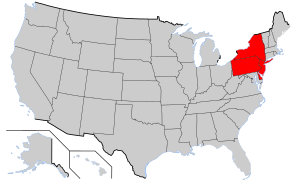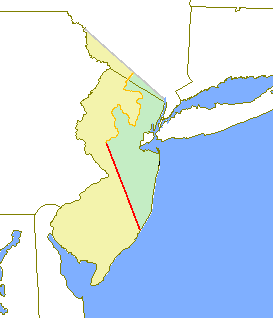Middle Colonies facts for kids
The Middle Colonies were a group of four important British colonies in North America. They were located between the New England Colonies to the north and the Southern Colonies to the south. These colonies included Delaware, New Jersey, New York, and Pennsylvania. Today, this area is often called the Mid-Atlantic states of the United States.
The Middle Colonies were known for their rich, fertile soil, which made them excellent for farming. They grew a lot of wheat and other grains, earning them the nickname "Bread Basket Colonies." They were also very diverse, with settlers coming from many different countries like England, Scotland, Ireland, the Netherlands, and Germany. This mix of people led to a unique culture with more freedom of religion than in other colonies.
Contents
The Story of the Middle Colonies
The story of the Middle Colonies began with Henry Hudson. In 1609, he explored the area for the Dutch East India Company. He sailed up the Hudson River and into Delaware Bay. The Dutch then explored and settled parts of this land, calling it New Netherland.
Later, in 1638, a Swedish colony called New Sweden was founded near Delaware Bay. However, the Dutch took control of this area in 1655. In 1664, the English took over most of New Netherland from the Dutch. They renamed it New York after the Duke of York. The Duke of York and the King of England then granted parts of this land to others. These new areas became the Province of New Jersey and the Province of Pennsylvania. The Delaware Colony later separated from Pennsylvania.
New Jersey: A Colony for Many People
King Charles II gave the land west of the Hudson River to his brother, the Duke of York. The Duke then gave this land to two friends, Sir George Carteret and Lord Berkeley. This area became the Province of New Jersey.
In 1665, a document called the Concession and Agreement was created. It offered religious freedom and promised no taxes without the approval of an assembly. This helped attract many settlers. The first governor was Philip Carteret, who founded Elizabethtown.
Over time, New Jersey was divided into East Jersey and West Jersey. But in 1702, Queen Anne united them into one Royal Colony. New Jersey eventually gained its own separate governor in 1738.
As the American Revolution approached, New Jersey's leaders took control. They arrested the Royal Governor, William Franklin, in 1776. New Jersey then helped declare independence from Britain, ending its time as a colony.
Pennsylvania: William Penn's "Holy Experiment"
King Charles II granted the land for Pennsylvania to William Penn in 1681. This was to pay a debt the King owed Penn's family. Penn wanted Pennsylvania to be a place of peace and religious freedom. He called it his "Holy Experiment."
Penn wrote a plan for the colony called the Frame of Government of Pennsylvania. It promised religious tolerance for many groups, including the Quakers and local Native Americans. Even though Penn governed the colony, its citizens were still under the laws of the English King.
In 1704, the Delaware Colony separated from Pennsylvania. Over the years, the people of Pennsylvania wanted more power for their elected officials. William Penn eventually agreed to add their Charter of Privileges to the constitution.
As tensions grew with Britain, Philadelphia, Pennsylvania's largest city, became a key meeting place. It hosted the Continental Congress, where leaders discussed independence. In 1776, Pennsylvania's own constitution marked the end of its colonial status.
New York: From Dutch to British Control
The first Dutch settlements in the New York area appeared around 1613. The English took over the New Netherland Colony from the Dutch in 1664. They renamed it New York after the King's brother, the Duke of York.
The Dutch briefly recaptured the colony in 1673. However, they gave it back to the English in 1674 in exchange for Suriname. The Duke of York appointed governors and councils to run the colony. Richard Nicolls was New York's first governor.
In 1665, the Province of New Jersey separated from New York. New York was the last colony to have an assembly, which met in 1683. This assembly drafted a constitution that gave colonists rights, including "no taxation without representation." However, the King later declared this constitution void.
When the Duke of York became King James II of England, New York became a royal province. There was a rebellion in New York called Leisler's Rebellion. Its leader, Jacob Leisler, was arrested and faced serious consequences for his actions. New York's charter and constitution were later brought back.
In 1775, American patriots formed the New York Provincial Congress. They replaced the royal government. New York's colonial status ended with the United States Declaration of Independence in July 1776.
Delaware: A Small but Important Colony
The Delaware Colony was a place that changed hands many times. It was controlled by the Dutch and Swedes between 1631 and 1655. The Dutch then kept control until 1664. That's when the English took over, renaming New Amstel to New Castle.
From 1664 to 1682, a deputy of the Duke of York governed Delaware. When William Penn received his land grant for Pennsylvania in 1681, he also received the Delaware area. He called them "The Three Lower Counties on the Delaware River."
Because Delaware had a very diverse population, Penn found it challenging to govern. In 1701, he agreed to let Delaware have its own separate colonial assembly. This gave the people of Delaware more say in their own government.
Geography: The Bread Basket Colonies
The Middle Colonies had very rich and fertile soil. This was different from the rocky soil found in the nearby New England Colonies. Because of this great soil, the Middle Colonies became known as the Bread Basket Colonies. They produced huge amounts of grain.
Pennsylvania was a top producer of wheat, corn, rye, hemp, and flax. It was the leading food producer among the colonies for many years. Wide, calm rivers like the Susquehanna River, the Delaware River, and the Hudson River were also important. They helped with trade and allowed for mills powered by water wheels. Fur trappers also used these rivers to travel.
Industry: Growing and Making Things
The Middle Colonies had many forests. This led to successful lumbering and shipbuilding industries. Deep river estuaries also helped create important ports like New York and Philadelphia.
While the Middle Colonies had more industry than the Southern Colonies, they didn't have as much as New England. In Pennsylvania, there were many sawmills and gristmills. The textile industry also grew quickly. Pennsylvania became a major producer of pig iron and products like the Pennsylvania long rifle and the Conestoga wagon. Other important industries included printing, publishing, and papermaking.
Politics: Early Steps Towards Self-Government
Political groups in the Middle Colonies started small. They grew into larger organizations, especially during the French and Indian War.
Generally, the Middle Colonies were run by governors appointed by the King or by proprietors. They also had elected Colonial Assemblies. Many constitutions in these colonies promised freedom of religion and stated that there should be "no taxation without representation."
Sometimes, royal governors faced challenges. For example, New Jersey's governor was arrested, and there was Leisler's Rebellion in New York. The growing desire for more self-rule in the Middle Colonies eventually made the region a center for the American Revolution. Philadelphia became the meeting place for the Continental Congress. However, not everyone supported the revolution; some people remained neutral or were Loyalists to the British King.
Demographics: A Diverse Population
The Middle Colonies were a mix of the New England Colonies and Southern Colonies in terms of their people. Most landholdings were farms of about 40 to 160 acres. These farms were usually owned and worked by families. However, in New York's Hudson Valley, large estates called patroonships existed. Here, tenants rented land from wealthy landowners.
The Middle Colonies were the most diverse of all the British colonies in North America. They were also more socially tolerant. For instance, in New York, any foreigner who was Christian could become a citizen. This led to a very mixed population. Many early German settlers came to the Middle Colonies.
Indentured servitude was common in Pennsylvania, New Jersey, and New York in the 1700s. This meant young people from Britain or Germany agreed to work for a family for a set number of years. In return, their trip across the ocean was paid for. Most of them became farmers or farm wives. By the mid-1700s, about 12% of New York's population were African American slaves. Most worked as house servants in Manhattan or on Dutch farms.
English Settlers and Their Influence
When the English took control around 1664, many Quakers from Rhode Island had already moved to the region. They had been pushed out by Puritans. Episcopalian businessmen settled in Philadelphia and New York City.
Welsh Quakers, Baptists, and Methodists settled in the Welsh Tract of Pennsylvania. The Middle Colonies also had a close relationship with some New England areas, like parts of Maine and Vermont, due to early land claims.
William Penn and the Lords Baltimore encouraged Irish Protestant immigration. They hoped these immigrants would work as indentured servants on their lands. Because of this, some areas of the Middle Colonies showed a strong Irish cultural influence.
Religious Freedom and Variety
The Middle Colonies were the most religiously diverse part of the British Empire. They had a high degree of tolerance for different faiths. The Penn family were Quakers, so Pennsylvania became a popular place for Quakers. It also attracted German Lutherans, German Reformed, and smaller groups like Mennonites, Amish, and Moravians. Scotch-Irish Presbyterians also settled there.
In upstate New York and New Jersey, the Dutch Reformed church was strong. Congregationalists were important in Long Island. A religious movement called the First Great Awakening made people more religious. It helped Congregational, Methodist, and Baptist churches grow.
There was even a Jewish community in New York (then New Amsterdam) as early as 1654. Jews also settled in Pennsylvania from 1655. This wide variety of religions made the Middle Colonies a unique place.
See also




